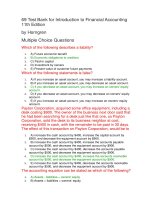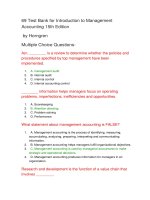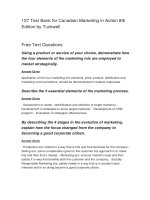Test bank for introduction to clinical pharmacology 8th edition by edmunds download
Bạn đang xem bản rút gọn của tài liệu. Xem và tải ngay bản đầy đủ của tài liệu tại đây (512.79 KB, 25 trang )
Test Bank for Introduction to Clinical Pharmacology 8th Edition by
Edmunds
Chapter 19: Immunologic Medications
Edmunds: Introduction to Clinical Pharmacology, 8th Edition
MULTIPLE CHOICE
1. Which term refers to a medication containing a weakened or
dead antigen?
a.
Toxoid
b.
Vaccine
c.
Antiserum
d.
Antidote
ANS: B
Laboratories can produce vaccines that contain either attenuated or killed
antigens so that people can be immunized to prevent them from getting
the disease.
DIF: Cognitive Level: Remember
TOP: Vaccines
REF: p. 400
OBJ: 1
KEY: Nursing Process Step: N/A
MSC: NCLEX: Safe, Effective Care Environment: Safety and Infection Control
2. TD (tetanus and diphtheria) boosters are recommended at
which interval?
a.
Every 5 years
b.
Every 7 years
c.
Every 10 years
d.
Every 15 years
ANS: C
TD (tetanus and diphtheria) boosters are recommended every 10 years.
DIF: Cognitive Level: Remember
OBJ: 3
REF: p. 401 | Table 19-1
TOP: Immunization Schedule
KEY: Nursing Process Step: Planning
MSC: NCLEX: Safe, Effective Care Environment: Safety and Infection Control
3. A patient comes into the clinic with complaints of a cold. He is also there
for a flu shot. Which represents the reason a flu shot is not
recommended in this case?
a.
Active infection is present.
b.
WBCs are too low.
c.
CBCs are high.
d.
Susceptibility is down.
ANS: A
The best policy is that immunizations should not be given to patients with
active infection, severe febrile illness, or history of a serious side effect from
previous vaccinations.
DIF:
Cognitive Level: Understand
TOP: Immunizations
Process Step: Planning
REF: p. 403
KEY:
OBJ:
4
Nursing
MSC: NCLEX: Safe, Effective Care Environment: Safety and Infection Control
4. The nurse would recommend a yearly influenza virus vaccine to which
person?
a.
Teenager
b.
Young mother
c.
Middle-aged man
d.
Older adult woman
ANS: D
Older adults are at high risk for pneumonia and flu, so it is recommended
that this patient population receive the annual flu vaccine to prevent infection.
DIF:
Cognitive Level: Understand
TOP: Vaccines
REF: p. 402
OBJ: 3
KEY: Nursing Process Step: Planning
MSC: NCLEX: Physiological Integrity
5. Protection from which infectious disease can be offered by routine
immunization with PCV (children) or PPV (adults) vaccine?
a.
Streptococcus pneumoniae
b.
Typhoid
c.
Cholera
d.
Toxoid
ANS: A
Pneumococcal conjugate vaccine (PCV) for children and pneumococcal
polysaccharide vaccine (PPV) for adults produce immunity against a variety of
pneumococcal infections. Since Streptococcus pneumoniae is responsible for
illnesses ranging from ear infections to meningitis, blood infections, and
pneumonia, the Centers for Disease Control and Prevention recommend the
polyvalent pneumococcal vaccines for all children and susceptible adults.
DIF:
Cognitive Level: Understand
OBJ: 3
Diagnosis
TOP: Vaccines
REF: p. 403 | Table 19-1
KEY: Nursing Process Step:
MSC: NCLEX: Physiological Integrity
6. Which patient is at an increased risk if using an immunologic agent?
a.
A postal worker
b.
A college student
c.
A neonate
d.
A pilot
ANS: C
There is an increased risk in using immunologic agents in any person with a
compromised immune status, for example, neonates, older adult patients,
and patients on immunosuppressive therapy.
DIF:
Cognitive Level: Analyze
TOP: Immunizations
Process Step: Assessment
REF: p. 403
KEY:
OBJ:
4
Nursing
MSC: NCLEX: Physiological Integrity
7. The nurse observes the arm of a patient who was given the Mantoux
skin test for tuberculosis. There is induration of 3 mm. How should
the nurse document the results?
a.
Negative
b.
Questionable
c.
Positive for exposure
d.
Positive for TB
ANS: A
The Mantoux test is designed to identify people with active tuberculosis,
with exposure to tuberculosis, or needing further testing. Positive reaction
must have erythema and induration of 9 mm or more in size; a reaction of 5
to 9 mm is questionable, and areas under 5 mm are negative.
DIF:
Cognitive Level: Apply
OBJ: 5
REF: p. 402 | Table 19-1
TOP: Tuberculosis Testing
KEY: Nursing Process Step: Assessment MSC: NCLEX: Physiological
Integrity
8. A child is scheduled for immunizations, but the mother states that his
temperature has been 100.2° F all day. The nurse will take which action
next?
a.
Tell the mother to go home.
b.
Give the immunizations.
c.
Give a higher dose because of the fever.
d.
Tell the mother to wait 1 month.
ANS: B
Many children are taken to the health care provider only when they are ill, so
clinicians may have to give the immunizations then. Otherwise, they may
lose a very valuable opportunity to provide increased protection to the child.
DIF: Cognitive Level: Apply
REF: p. 403
OBJ: 3
KEY:
Nursing
TOP: Immunizations
Process Step: Implementation
MSC: NCLEX: Physiological Integrity
9. Which patient should take the varicella vaccine?
a.
A child who stepped on a rusty nail
b.
An adult who has never been immunized
c.
A health care worker
d.
Any child under 1 year of age
ANS: B
In special circumstances, certain biologic agents may be used to modify
a disease process in the previously unimmunized person.
DIF: Cognitive Level: Analyze
REF: p. 401 | Table 19-1
OBJ: 2
TOP: Immunizations
KEY: Nursing Process Step: Diagnosis MSC: NCLEX: Physiological
Integrity
10.
Which is the best intervention to relieve local discomfort from an
immunization?
a.
Application of emollients
b.
Application of ice
c.
Application of lidocaine ointment
d.
Acetaminophen
ANS: D
Localized discomfort may be relieved by treating the symptoms using warm
compresses to the area, acetaminophen, rest, and sometimes antihistamines.
DIF:
Cognitive Level: Apply
REF: p. 406
OBJ: 4
TOP: Immunizations
Process Step: Implementation
KEY:
Nursing
MSC: NCLEX: Physiological Integrity
11.
A mother has concerns about the immunization scheduled for this
clinic visit having adverse effects on her child. Which would be the
nurse’s best response to the mother?
a.
“The doctor wants the child to
b.
“We will give the heinjecxtionvisiat.
c.
“More complications are caused than by the
immunization.”
d.
“Side effects are expected, and worry about.”
ANS: C
Although some parents are afraid of adverse effects from immunizations, their
children are statistically more likely to have complications from the disease than
they are to experience serious side effects from the immunization.
DIF:
Cognitive Level: Apply
REF: p. 402
TOP: Immunizations
Process Step: Implementation
KEY:
OBJ:
4
Nursing
MSC: NCLEX: Physiological Integrity
12.
The biologic agent purified protein derivative (PPD) is used to
screen for exposure to which disease?
a.
Tuberculosis
b.
Yellow fever
c.
Pneumonia
d.
Cholera
ANS: A
Purified protein derivative (PPD) is used to screen people who have
been exposed to tuberculosis.
DIF:
Cognitive Level: Remember
REF: p. 402 | Table 19-1
OBJ: 2
TOP: Immunizations
ursing Process Step: N/A
KEY: N
MSC: NCLEX: Safe, Effective Care Environment: Safety and Infection Control
13.
Which biologic agents are used in a routine schedule for
active immunizations?
a.
PPD
b.
Toxoids
c.
Antigens
d.
Toxins
ANS: B
Toxoids are biologic agents used in the routine schedule of active
immunizations for adults and children.
DIF:
Cognitive Level: Understand
TOP: Immunizations
Process Step: N/A
REF: p. 402
KEY:
OBJ:
2
Nursing
MSC: NCLEX: Safe, Effective Care Environment: Safety and Infection Control
14.
Which is the nurse’s best means of determining is immunized against a
certain disease?
a.
Ask the patient for records.
b.
Look for vaccination scars.
c.
Call the health department.
d.
Obtain a blood titer.
ANS: D
Occasionally, determining antibody blood titers before vaccine
administration is helpful to assess antibody development.
DIF:
Cognitive Level: Understand
REF: p. 403
TOP: Immunizations
Process Step: Diagnosis
KEY:
OBJ:
3
Nursing
MSC: NCLEX: Safe, Effective Care Environment: Safety and Infection Control
15.
Which is an example of artificially acquired active immunity?
a.
Developing chickenpox as a child
b.
Developing measles as an adult
c.
Receiving a PPD yearly
d.
Receiving prophylactic vaccines
ANS: D
Artificially acquired active immunity is given by a vaccine that contains either
attenuated or killed antigens that prevent patients from getting diseases.
DIF: Cognitive Level: Understand
TOP: Artificially Acquired Immunity
REF: p. 401
OBJ: 2
KEY: Nursing Process Step: N/A
MSC: NCLEX: Physiological Integrity: Physiological Adaptation
16.
Which patient is at high risk for needing a booster injection of
vaccine?
a.
A 45-year-old high school secretary
b.
A second-grade student
c.
A teacher just finishing college
d.
A soldier on active duty
ANS: D
Few adults obtain the booster immunization they need unless they are in the
military, travel to foreign countries, or work in the food industry.
DIF: Cognitive Level: Analyze
TOP: Immunizations
Process Step: Diagnosis
MSC: NCLEX: Physiological Integrity
REF: p. 403
KEY:
OBJ: 3
Nursing
17.
Why is it important for the nurse giving a vaccine to know
whether the patient has an allergy to eggs and feathers?
a.
Many biologic agents come from chick embryos.
b.
Viruses are found in all eggs.
c.
Chicken egg cells are close to human cells.
d.
There is clotted blood in egg cells.
ANS: A
Many biologic agents are prepared with animal serum or chick embryos; thus,
people with known allergies may have sensitivity reactions to these
preparations.
DIF:
Cognitive Level: Understand
TOP: Sensitivity Reactions
Process Step: Assessment
REF: p. 402
KEY:
OBJ:
4
Nursing
MSC: NCLEX: Physiological Integrity
18.
The development of immunity to the chickenpox virus after
having the disease is an example of which kind of immunity?
a.
Passive
b.
Artificial
c.
Natural
d.
Antigen
ANS: C
After getting chickenpox, a child develops antibodies to the virus that travel
around
in
the
bloodstream
for
the
rest
of the
DIF:
Cognitive Level: Understand
TOP: Immunity
N/A
REF: p. 396
KEY: Nursing Process Step: N/A
OBJ: 2
MSC: NCLEX:
19.
Which circumstance indicates that a 5-year-old about to enter
grade school should be screened for current illness before receiving her
immunizations?
a.
She will cry and hurt too much.
b.
Her father is chronically ill at home.
person’
c.
She has another year before she needs them.
d.
Her mother passed immunity to her at birth.
ANS: B
Patients should be screened for current illness because there is an increased
risk in using immunologic agents in people with compromised immune status.
DIF: Cognitive Level: Apply
TOP: Immunizations
Process Step: Assessment
REF: p. 403
KEY:
OBJ: 3
Nursing
MSC: NCLEX: Physiological Integrity
20.
A patient asks the nurse why she needs a booster of tetanus
toxoid after she cut her finger, since she already had a shot when she
was a child. What should the nurse explain the booster produces?
a.
Active immunity
b.
Natural immunity
c.
Protective antibodies
d.
Passive immunity
ANS: C
Some diseases require periodic booster injections of vaccine to keep the
antibody level high enough to protect the patient.
DIF: Cognitive Level: Apply
TOP: Immunity
REF: p. 401
OBJ: 3
KEY: Nursing Process Step: Implementation
MSC: NCLEX: Physiological Integrity
21.
How are foreign substances in the bloodstream removed from the
body?
a.
The filtering system of the liver
b.
Water in the large intestine
c.
Urine moving though the ureters
d.
The lymphatic system
ANS: D
The immune system is a part of the lymphatic system, which removes foreign
substances from the blood and lymph.
DIF:
Cognitive Level: Remember
TOP: Immune System
REF: p. 396
OBJ: 1
KEY: Nursing Process Step: N/A
MSC: NCLEX: N/A
22.
A 25-year-old patient believed that he still had immunity to
childhood illnesses until he developed chickenpox. What is the
best explanation of this situation made by the nurse to the patient?
a.
He never had an injection for immunity.
b.
Artificially acquired active im always confer lifelong
immunity.
c.
He never got a booster as a child.
d.
There was no immunity injection for this disease.
ANS: B
Some early immunizations lose their ability to provide long-term immunity.
DIF: Cognitive Level: Apply
TOP: Immunity
REF: p. 401
OBJ: 2
KEY: Nursing Process Step: Implementation
MSC: NCLEX: Physiological Integrity
23.
Patients receiving immune serums should be evaluated for which
effect?
a.
Headaches
b.
Skin rash
c.
Disease suppression
d.
Numbness in the fingers
ANS: C
Patients receiving immune serums should be evaluated for suppression of
the disease.
DIF: Cognitive Level: Understand
TOP: Immunity
REF: p. 403
KEY: Nursing Process Step: Evaluation
MSC: NCLEX: Physiological Integrity
OBJ: 4
24.
A female patient brings her newborn in to the clinic for
immunizations. During the visit, the patient asks the nurse what is
naturally acquired passive immunity. What is the best example
provided by the nurse?
a.
Immunity through breastfeeding an infant
b.
Immunity through immunoglobulins
c.
Immunity through an attenuated or weakened
toxin
d.
Immunity through having and recovering from a
disease
ANS: A
Naturally acquired passive immunity is a type of temporary immunity that can
occur when antibodies pass from the mother to the fetus through the
placenta or to the nursing infant through breast milk.
DIF:
Cognitive Level: Understand
TOP: Immunity
REF: p. 401
OBJ:
KEY: Nursing Process Step: Implementation
MSC: NCLEX: Physiological Integrity
MULTIPLE RESPONSE
1
25.
Pneumococcal vaccine produces immunity against which
illnesses? (Select all that apply.)
a.
Pneumonitis
b.
Meningitis
c.
Pneumonia
d.
Pertussis
e.
Influenza
ANS: B, C
Pneumococcal vaccine provides active immunization for infants and children
against pneumonia and meningitis caused by Streptococcus pneumoniae.
DIF:
Cognitive Level: Remember
TOP: Immunizations
Process Step: N/A
REF: Table 19-1
OBJ: 3
KEY:
Nursing
MSC: NCLEX: N/A
26.
Infants and children are immunized to prevent
which diseases? (Select all that apply.)
a.
Hepatitis B
b.
Hepatitis C
c.
Polio
d.
Varicella
e.
Lyme disease
ANS: A, C, D
Infants and children can be immunized against hepatitis B, polio, and
varicella in addition to several other conditions.
DIF: Cognitive Level: Remember
TOP: Immunity
REF: p. 401
KEY: Nursing Process Step: Diagnosis
MSC: NCLEX: Physiological Integrity
27.
Which may be used to relieve localized discomfort
after immunization injections? (Select all that apply.)
a.
Warm compresses
OBJ: 3
b.
Acetaminophen
c.
Antihistamines
d.
Decongestants
e.
Rest
ANS: A, B, C, E
Treating localized discomfort after an immunization injection is done with
warm compresses to the area, acetaminophen, rest, and sometimes
antihistamines.
DIF:
Cognitive Level: Apply
REF: p. 406
OBJ: 4
TOP: Immunizations
Process Step: Implementation
KEY:
Nursing
MSC: NCLEX: Physiological Integrity
28.
Which statements are correct concerning vaccines and
toxoids? (Select all that apply.)
a.
They are biologic agents that produce active
immunization.
b.
They are biologic agents that produce passive
immunization.
c.
They are prepared with animal serum.
d.
They are considered a blood product.
e.
They are only used in children.









